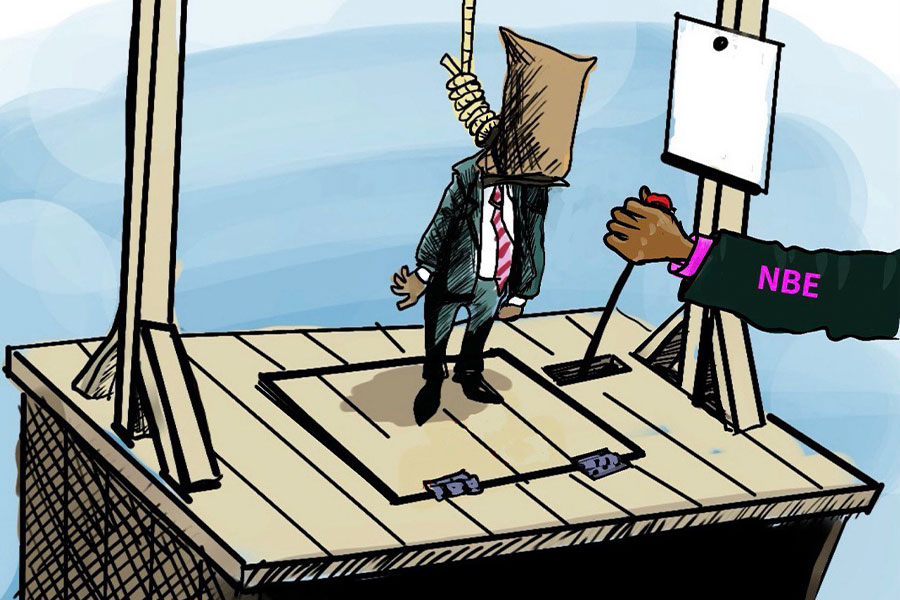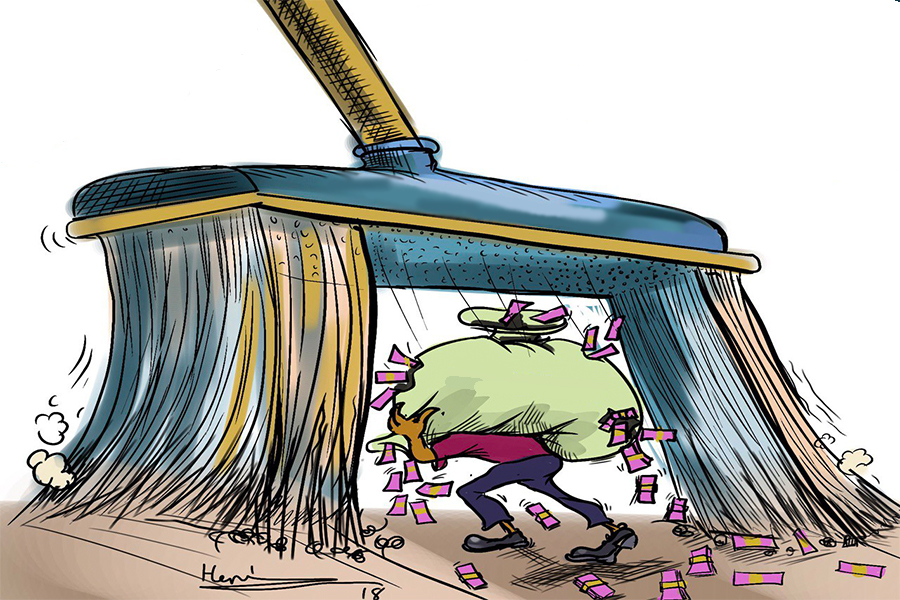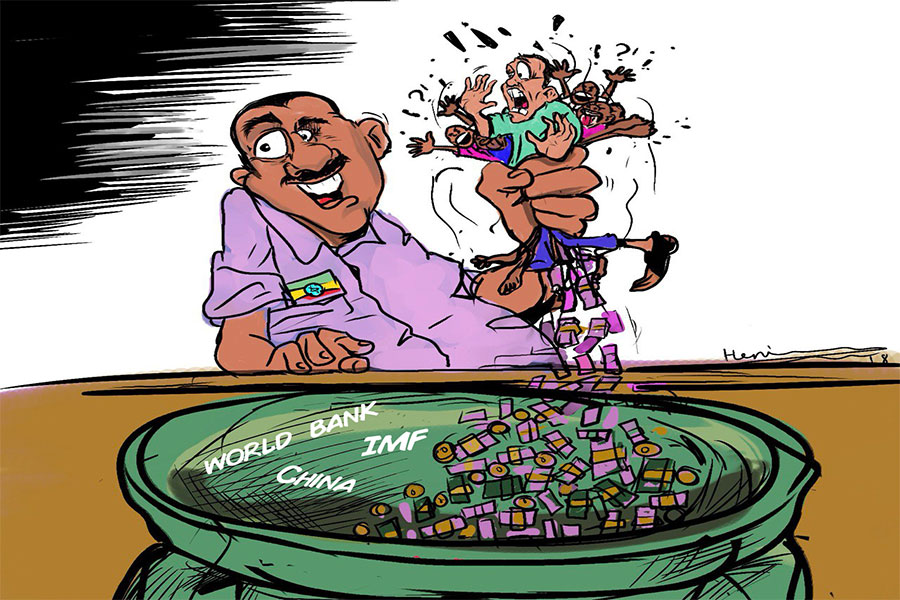
Photo Gallery | 180207 Views | May 06,2019
Sep 21 , 2025. By BEZAWIT HULUAGER ( FORTUNE STAFF WRITER )
Public debt reached 71.4 billion dollars, equal to 34.8pc of its GDP, a sharp drop from 49pc two years earlier. But this figure, hailed in official circles, concealed a web of vulnerabilities. State borrowing has long underpinned infrastructure ambitions, yet missed Eurobond payments and tight liquidity have cast new doubts on Ethiopia's economic prospects. Much of the improvement in the debt-to-GDP ratio is driven not by repayments, but by rapid nominal GDP growth and a halt in new external loans.
Ethiopia has reached a critical juncture after years of aggressive borrowing to fund a state-led growth model. It now finds itself in the crosshairs of global financial scrutiny, following last week's disclosure of the World Bank and the International Monetary Fund's (IMF) assessment that its public debt is “unsustainable.”
The verdict was expected but no less consequential. Months earlier, Ethiopia missed a 33 million dollar interest payment on its lone Eurobond, issued in 2014. Once seen as a rising African economy with rapid growth and ambitious infrastructure plans, the country is now mired in fiscal fragility, liquidity constraints, and diminished investor confidence.
For decades, Ethiopia’s development strategy was built around state dominance. Grand infrastructure projects, financed mainly through foreign loans, were heralded as engines of growth. However, slow export performance, declining donor support, and rising debt repayments have exposed the underlying fragility of this approach. By June 2024, its public and publicly guaranteed debt had reached 71.4 billion dollars, 34.8pc of GDP, down from 49pc two years earlier.
But this apparent improvement masks deeper vulnerabilities. The decline is attributed mainly to nominal GDP growth and a tightening of external borrowing, not meaningful deleveraging. Underneath, the structure of the debt remains precarious. Roughly half of the debt is owed to multilateral and bilateral lenders, including China. The balance is domestic. However, the federal government’s reliance on domestic debt markets has been growing, and yields on Treasury bills (T-bills) have surged to 16.4pc, more than double last year’s average, as liquidity tightens and inflation expectations rise.
The Eurobond default has impacted Ethiopia’s reputation in international markets. Its EMBI spread has soared past 1,000 basis points, signalling deep distress. Foreign direct investment has slowed, and planned privatisation proceeds are conspicuously absent from budget documents. Sovereign and corporate ratings are under pressure. Ethiopian Reinsurance, for example, has seen its rating jeopardised by country risk.
Ethiopia’s official and commercial creditor debts, 525 million dollars and 32 million dollars, respectively, include loans dating back to the 1980s. Some lenders, including those from the former Yugoslavia, remain unresolved. The longer restructuring takes, the deeper the economic costs. Rising debt pressures are increasingly felt by citizens. Public service charges have surged, and tax reforms meant to broaden the base have translated into heavier burdens for ordinary Ethiopians, leaving households acutely aware of the costs of the debt crisis.
The latest joint World Bank-IMF Debt Sustainability Analysis (DSA) offers an unambiguous conclusion. Ethiopia’s external debt path violates key thresholds, and even under favourable assumptions, debt indicators remain elevated well past 2028.
“Ethiopia’s debt is assessed to be unsustainable, mainly due to protracted breaches of exports-related external debt indicators and a weak debt-carrying capacity,” the DSA states.
The foreign exchange reserves, pegged at four billion dollars by April 2025, remain low by international standards, covering less than three months of imports.
Efforts to restructure Ethiopia’s debt under the G20 Common Framework began in late 2023, securing a temporary suspension of bilateral payments through 2024. However, negotiations with private bondholders have stalled. A draft memorandum of understanding, floated in March 2025 to close a 10.8 billion dollars external financing gap by 2028, remains unsigned. The deadlock has forced the government to lean harder on domestic borrowing.
According to the analysis, fiscal authorities have converted short-term T-bills into long-term bonds and issued recapitalisation tools to mitigate rollover risks. Domestic debt now equals 19.3pc of GDP.
An IMF-backed program to restore debt sustainability by 2028 has outlined an ambitious roadmap for currency liberalisation, curbing quasi-fiscal spending by state-owned enterprises (SOEs), realigning subsidies, and promoting market-based debt issuance. Many view these as politically fraught prescriptions. Fuel and fertiliser subsidies, once hidden through exchange rate arbitrage, have now been brought onto the federal budget.
From 2025/26, fuel taxes (worth 0.8pc of GDP) will no longer be ring-fenced for the Ethiopian Petroleum Supply Enterprise or Road Fund. However, cash transfer programs are being expanded to cushion the poor. Public revenues remain low, governance capacity is stretched, and the lingering effects of conflict cast a long shadow. The IMF projects GDP growth of 7.2pc in 2024/25, but its experts warn that this depends heavily on a successful restructuring deal and export recovery.
To manage the elephant in the room, SOE debt, the government created the Liability & Asset Management Corporation (LAMC) in 2021, with an authorised capital of 570 billion Br. LAMC assumed nearly 800 billion Br of SOE liabilities, most of it from the Ethiopian Sugar Corporation (ESC), Ethiopian Electric Power (EEP), and Ethiopian Railway Corporation (ERC), which together hold 90pc of the debt by the state-owned enterprises.
The federal government’s new asset manager, the Ethiopian Investment Holdings (EIH), claims to be turning things around. It reported two trillion Birr in revenue and 262.7 billion Br in pre-tax profits for the year 2024/25, representing an 88pc rise. Ethiopian Airlines (67pc), the Commercial Bank of Ethiopia (CBE), with 15pc share, and Ethio telecom (10pc) led the way. CEO Brook Taye (PhD) has set even higher targets for 2025/26.
However, some experts remain sceptical. They see profitable outliers, such as Ethiopian Airlines, as masking deeper structural issues. CBE’s growing exposure to risky SOE debt threatened its balance sheet, while Ethio telecom faces operational challenges from stalled liberalisation and declining margins.
Dakito Alemu (PhD), a lecturer at the Addis Abeba University, warned that weak credit ratings damage investor confidence, raising borrowing costs and restricting new investment.
“As risk and return are directly linked, a default increases borrowing costs,” he said.
Much of the country’s defaulted loans are commercial, and although the G20 framework allowed for restructuring, the process remains uneven.
For domestic debt, experts note that default is virtually impossible. According to Dakito, the government can issue new money to meet obligations, with the main risk being inflation. A domestic default would trigger a liquidity crunch. To mitigate pressures, he recommended arbitration with lenders, alternative income-generation methods, disciplined repayment from SOEs, and a focus on debt optimisation and efficient tax collection to secure the future.
For Mikiyas Mulugeta (PhD), an economist with the Centre for African Leadership Studies, the financial tools alone are not enough. According to him, EEP carries the largest utility debt load in sub-Saharan Africa, and requires not only refinancing but a full strategic overhaul.
According to Fikru Tsegaye, vice president of Ethiopian Reinsurance, they have been rated double B by AM Best Credit Rating an international credit rating company. The firm, while the business is sound, global agencies challenge them for operating in a high-risk jurisdiction. With 95pc of revenues earned locally, there remains little buffer.
“Even though the economy is strong, the debt default still affects our rating,” Fikru told Fortune, stating the company’s dependence on national support and sustainable practices to maintain its position.
To avoid a domestic default, which Mikiyas argues would “spark a severe liquidity crisis,” the government should maintain discipline, arbitrating repayment terms, curbing wasteful SOE projects, and improving tax collection. He urged federal officials to explore new income streams, from public asset leases to diaspora bonds.
Girum Amaha, another economist who heads regulatory strategy and marketing intelligence at Fenan Pay, estimated fuel tax revenues at 9.4 billion dollars, with seven billion dollars allocated for subsidies, and 3.5 billion dollars for fertiliser support. These fiscal outflows tighten the room for manoeuvre, making careful macroeconomic management critical.
The World Bank and IMF debt simulations forewarn that without substantial reforms, the present value of debt-to-GDP could reach 44pc by 2025/26, falling below critical thresholds only after 2028/29. Until then, they warn, Ethiopia remains in a high-risk zone, vulnerable to commodity price shocks, exchange rate volatility, and investor retreat.
The joint DSA urged for debt treatment and robust reform to enable Ethiopia to exit its current state of debt distress. It cautioned that failure to act decisively could condemn the country to a decade of stagnation and austerity.
Federal authorities have pinned hopes on exports and remittances to boost foreign currency reserves. Exports of goods and services are projected to hit 12pc of GDP in 2024/25, up from 9.6pc during the second review, driven by volume growth and historically high prices for coffee and gold. Girum cautioned, however, that these gains displayed global commodity price movements more than domestic reform efforts.
PUBLISHED ON
Sep 21,2025 [ VOL
26 , NO
1325]

Photo Gallery | 180207 Views | May 06,2019

Photo Gallery | 170404 Views | Apr 26,2019

Photo Gallery | 161422 Views | Oct 06,2021

My Opinion | 137257 Views | Aug 14,2021

Nov 1 , 2025
The National Bank of Ethiopia (NBE) issued a statement two weeks ago that appeared to...

Oct 25 , 2025
The regulatory machinery is on overdrive. In only two years, no fewer than 35 new pro...

Oct 18 , 2025
The political establishment, notably the ruling party and its top brass, has become p...

Oct 11 , 2025
Ladislas Farago, a roving Associated Press (AP) correspondent, arrived in Ethiopia in...